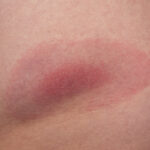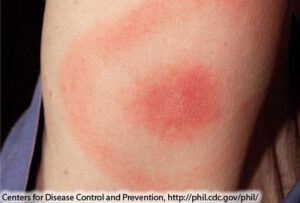Key Facts
- Infected ticks that attach to the skin can cause Lyme disease.
- Symptoms can be mild to severe, but most people get better with treatment.
- There are ways to protect yourself against Lyme disease.

If you live near the coast in the northeast part of the United States, the mid-Atlantic region, Wisconsin, Minnesota, Virginia, Iowa, Pennsylvania, Michigan, California, or some parts of Europe or Asia, you likely have heard about Lyme disease, as most cases occur in these areas.
What is Lyme disease?
Lyme disease is a bacterial infection that’s caused by the bite of an infected tick. The name “Lyme” comes from the town of Old Lyme, Connecticut where the illness was first recognized back in the mid 1970’s. Ticks most often live in tall grass or in heavily wooded areas. Although it’s a year round problem, April – October is said to be “tick season” (in the United States). June is the peak month in the northeast. Symptoms can be mild to severe, but most people get better with appropriate treatment.
Who is at risk for Lyme disease?
Anyone can get Lyme disease, but people who spend time in woody or brushy areas where deer ticks and Lyme disease are more common are at a greater risk of becoming infected. People with a deer tick attached to their skin for more than 72 hours are at a much greater risk of getting infected than those with a recently attached tick.
What causes Lyme disease?
Lyme disease is caused most often by a bite from an infected deer tick. The deer tick is much smaller (about the size of a freckle) than the dog tick. There are other illnesses that are caused by ticks, but Lyme disease is definitely the most common type of tick-borne illness in North America and Europe.
A tick becomes infected when it attaches itself and feeds off the blood of an infected host (usually a deer or mouse). Lyme disease is spread when an infected tick attaches itself to the next host and releases the bacteria in the bloodstream. Most tick bites do not cause Lyme disease, but the longer an infected tick stays attached to the host, the greater the risk of getting it. For transmission the tick usually needs to be attached for 2-3 days.
What are the symptoms of Lyme disease?
A person can get bitten by an infected tick and not have any symptoms of Lyme disease (or not have symptoms later). Others have symptoms. If you develop Lyme disease, you may notice a small red bump (where the tick attached) within 3-14 days after the bite of an infected tick. The bump is often warm to the touch and slightly sore. The bump usually spreads into a rash that looks like a “bull’s-eye”–pink in the center and deeper red on the outside called “erythema migrans.”

Other signs can appear after several days or weeks, and are similar to flu symptoms:
- Chills
- Fever
- Headache
- Body aches
- Feeling tired
Later, more advanced symptoms may include:
- Itching
- Tiredness
- Weakness
- Sore, inflamed, swollen joints (knees especially)
- Stiff neck
- Eye problems
- Memory Problems
- Problems with balance
- Neurological problems such as encephalopathy, meningitis, and facial nerve palsy (one side of face droops)
- Irregular heart rhythm
How is Lyme disease diagnosed?
Lyme disease can be hard to diagnose because not everyone has symptoms. The most common symptom is a rash, which 70-80% of people with Lyme disease get. Therefore, diagnosis is usually based on symptoms, history of a tick bite, and/or recent time spent in areas where Lyme disease is common.
A blood test(s) is usually done to check for antibodies to Lyme disease (antibodies are substances produced by your immune system to fight infection). However, because our bodies don’t make antibodies until a few weeks after an infection, the blood test may be negative if checked early and with treatment may never be positive.
What happens if I’ve been bitten by a tick?
If you’ve been bitten by a tick and the tick is attached to your skin, tell your parent/guardian so they can help you remove the tick as soon as possible. Only ticks that are attached to the skin can release the bacteria into the host. The longer the tick is attached to the skin, the more risk of getting infected with Lyme disease.
Do:
- Use sharp pointed tweezers or “tick tweezers.”
- Hold the tweezers and grab the tick as close to the skin as possible-near the tick’s mouth.
- Hold tightly and pull the entire tick out with a slow, steady motion.
- If parts of the tick break off and stay in the skin, use the tweezers to remove them.
- Once the tick is completely removed, clean the area and your hands with soap and water or rubbing alcohol.
- The deer tick is very small, about the size of a freckle. If you are not sure if the tick you removed was a deer tick, you can put it in a sealed bag, so your HCP can look at it.
If you are sure it was a tick, simply flush it down the toilet. Don’t:
- Do NOT use bleach, nail polish remover, petroleum jelly, or other ointments on your skin – these won’t remove the tick!
- Do NOT burn the tick out-this does NOT work and it can burn your skin and cause scarring.
- Do NOT twist the tick out-this may cause the tick to break apart and not come out completely.
- Do NOT squish or crush the tick with your hands to kill it.
Know when you are at risk and protect yourself against Lyme disease. If you are bitten by a tick, call your health care provider to see if you need to make an appointment and get treated, if needed. If your HCP feels you are risk of getting infected (the tick was attached for 36 hours or more), you may need to have a blood test and/or take an antibiotic. If very early, the blood test may still be negative.
What is the treatment for Lyme disease?
The standard treatment for Lyme disease is antibiotics taken by mouth. The best antibiotic is Doxycycline, but Amoxicillin and Cefuroxime are also good for treatment. The length of treatment may vary depending on symptoms and the type of antibiotics used. If you are taking Doxycycline you may only receive one single dose or you may receive a 10-28 day course, depending on symptoms. If symptoms progress, intravenous (IV) antibiotics may also be prescribed, requiring hospitalization. . The Food and Drug Administration (FDA) warns people not to take an injectable medicine called “Bismacine” for Lyme disease which is sometimes prescribed by alternative medicine practitioners.
How can you prevent Lyme disease?
If you spend time in areas where Lyme disease is common, you can lower your risk by protecting yourself.
- Wear long sleeve shirts and long pants if you know you’ll be spending time outside in wooded areas or near tall grass. Light colored clothing may make it easier to see ticks as well.
- Walk on clear paths and paved roads whenever possible when you’re in wooded and high grass areas.
- If you have pets, check them for ticks when they come in from outside.
- Check yourself and have someone look at areas of your skin and scalp that you can’t see, especially behind your knees, between fingers and toes, underarms, and groin.
- Use insect repellant that contains 20-30% DEET. These products don’t kill ticks, but work to keep ticks off.
- Take a shower after all outdoor activities are over for the day. (Showering will help remove any unattached ticks.)
Our health guides are developed through a systematic, rigorous process to ensure accuracy, reliability, and trustworthiness. Written and reviewed by experienced healthcare clinicians from Boston Children's Hospital, a Harvard Medical School teaching hospital and consistently ranked as a top hospital by Newsweek and U.S. News & World Report, these guides combine clinical expertise, specialized knowledge, and evidence-based medicine. We also incorporate research and best practices from authoritative sources such as the CDC, NIH, PubMed, top medical journals, and UpToDate.com. Clinical specialists and subject matter experts review and edit each guide, reinforcing our commitment to high-quality, factual, scientifically accurate health information for young people.
